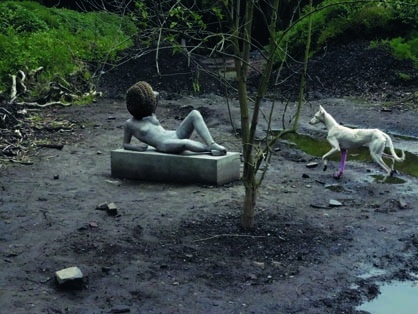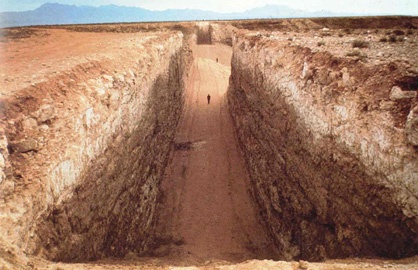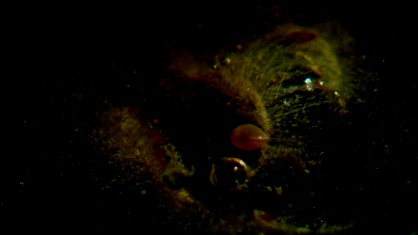Against Representation
 Pierre Huyghe, „Untilled“, 2012, dOCUMENTA (13), Kassel, installation view
Pierre Huyghe, „Untilled“, 2012, dOCUMENTA (13), Kassel, installation view
What does it mean to ask art to represent itself as image? What happens when the same is demanded of the viewer, the user? And critically, what results when an artwork or person interrupts this command? These questions take on particular resonance when assuming the position that works of art are never static forms, but rather, active devices for configuring flows of images.
In his text – which revisits “Untilled” (2012), Pierre Huyghe’s spectacularly diffuse contribution to dOCUMENTA (13) – art historian David Joselit considers the relationship between a work of art and its materiality, which, he argues, might be less stable than many assume.
“An image is a situation. I understand images in that way, not photographically. A situation is an image.” [1] – Pierre Huyghe
In his contribution to dOCUMENTA (13), Pierre Huyghe deposited an array of plant, mineral, animal, and human elements in a forlorn composting area of Karlsaue Park in Kassel. “Untilled” (2012) included a man, two dogs (one a white Podenco with a foreleg painted bright pink), a pile of concrete slabs, and various other components all amidst a muddy profusion of plant life. [2] Within this aesthetico-cultural compost stood the sculpture of a reclining nude, a giant swarm of bees in place of her head. At the heart of “Untilled”, then, was a hive mind whose constituent beings dispatched themselves to various plants in the neighborhood, helping to establish an integrated ecology. What emerged from this moldering compost of objects were images: Not just one image, but as many as there were impressions conceived by spectators. And while every artwork functions in this way – as a device for receiving and transmitting images – “Untilled” resisted its own smooth functioning, producing a theater of meaning’s ruin; its collapse into compost.
It is common to find meaning in art by linking a physical substrate – such as a painting by Raphael – to a singular image, like a Madonna and Child. In doing so, however, we make a false equation – an exchange – between a finite quantum of matter and a unique image. In fact, artworks generate an unending sequence of meanings by formatting configurations of image flows: They establish a dynamic situation rather than locking a signifier to a signified. In her analysis of Byzantine icons, Marie-José Mondzain recognizes this condition by speaking of artworks in terms of economies. In her view, the icon, like Huyghe’s “Untilled”, instantiates a kind of ecology: “The economic relation of the artificial icon to the natural image [of God as manifest in Christ] concerns precisely the organization and function of visibility in its relation to the invisible image, which remains the only true image.” [3] The icon does not represent Christ, but rather articulates the economy of his appearance – as an image of God that is always absent from the believer’s presence in the moment of contemplation. The mystery of Christ lies in his becoming an image of God from the material substrate of a human body. The icon restages this becoming-image belatedly for the worshipper, which is why Mondzain can declare, “the icon is nothing other than the economy of the image.” [4]
This economy is what Huyghe calls a situation. While according to Mondzain Byzantine icons were devoted to diagramming God’s self-revelation through intricate ratios of visibility and invisibility, “Untilled” secularizes the question: How can dissimilar strata of matter and life compose themselves into a world? Or, put differently, how can a distribution of distinct objects generate an image (i. e., an imaginary shared or social space)? Jean-Luc Nancy offers a persuasive answer to this question when he writes, “The image disputes the presence of the thing. In the image, the thing is not content simply to be; the image shows that the thing is and how it is […]. This is not a presence ‘for a subject’ (it is not a ‘representation’ in the ordinary, mimetic sense of the word). It is, on the contrary, if one can put it this way, ‘presence as subject’ […]. The thing presents itself.” [5] In short, Nancy proposes that images disclose an economy of objects. And indeed, in “Untilled”, the spectator must compose Huyghe’s layered accumulation of unlike materials – a kind of “ecology kit” – by trying (and very likely, failing) to make a coherent image from it. As I have already stated, such an operation occurs whenever one looks at an artwork or any visual artifact, but Huyghe’s work assertively resists synthesis, whereas a Raphael Madonna or a Byzantine icon, or for that matter an appropriated photograph by Richard Prince or Sherrie Levine, makes sophisticated use of mimesis in order to guide the viewer toward a stable representation. In “Untilled” what is at issue is precisely the strangeness, the volatility, experienced in causing matter to represent itself as an image. Even in canonical practices of Land Art of the 1970s there was typically an overarching form – a spiral in Robert Smithson’s “Spiral Jetty” or a “Double Negative” in Michael Heizer’s eponymous work – which, if not exactly clear in its significance, created a powerful emblem. And whereas in installations or Happenings since the 1960s there was either a score or an ambiance (or both) to suggest the possibility of some semblance of compositional unity, “Untilled”, like much recent “aggregative art”, [6] lacked not only an emblem but also a score, or any secure perimeter in which to detect ambiance. The work’s title even signals such lack of compositional fixity in its simultaneous reference to an absence of cultivation – “Untilled” – and its pun on the common designation for an unnamed artwork, “Untitled”. Nancy’s use of the term “dispute” is significant in this regard. When he writes, “the image disputes the presence of the thing,” he makes it clear that the mimetic impulse to represent by equating an object with an image is in reality an agonistic one, prone to misinterpretation and disagreement. The image, he implies, betrays objects rather than serving them.
 Michael Heizer, „Double Negative“, 1969–70
Michael Heizer, „Double Negative“, 1969–70
Huyghe’s film, “A Way in Untilled” (2012) models how an image stream might be harvested from the compost in Karlsaue Park. Except for the quasi-anthropomorphic movement of the camera, there is no evidence of human life in “A Way in Untilled”. Instead, the film suggests a visual and aural swarm: Sudden cuts from one brief scene of animal activity to another, often in vivid close-up, accumulate, but follow no discernible physical path or narrative. The soundtrack amplifies swarm sounds like the buzz of bees around the hive head of the reclining nude sculpture, crackling underbrush, and the Podenco’s gnawing of a sheep’s head bone. Scenes are often nocturnal, giving them a vivid otherworldly atmosphere; and when daylight does come it is almost blinding. In its resemblance to nature films (while lacking this genre’s moralizing narratives of struggle and survival), “A Way in Untilled” introduces a radically different scale – which implies the incommensurate perceptual horizon of the insect or the dog, but also the capacities of the machine to record sounds and scales inaccessible to human senses. Here the “disputation” between images and things posited by Nancy is allegorized as the unbridgeable difference between species; and between the living and the machinic.
Despite concerted attacks against it, the category of medium has been hard to shake. Its familiar, and now discredited modernist version stipulates that the material possibilities and limits of a practice like painting in general (or sculpture, or photography, et cetera) serve as the content of every individual painting (or sculpture or photograph). Decades of theoretical work have discredited this perspective, but in its place a “secularized” but ideologically potent version of medium-specificity lives on. This “secular” mode [7] inheres not in art’s craft traditions (i.e., painting, sculpture, photography) but in the persistent conviction that a highly motivated, even “natural,” connection exists between an artwork’s physical substrate and the images generated from it; its signifier and signified. This assumption is present, for instance, in those contemporary tendencies that would seem the antithesis of modernist art: Research-based forms of institutional or sociocultural critique. While such works do not practice medium-specificity per se, they do depart from a fundamental belief in the link between the artwork’s substrate and the images it produces: Indeed in order for art to attempt an explicit form of critique, it must posit a motivated relationship between its physical form and a specific message. “Untilled” presents a countermodel to such an ideology of adequation, for in Huyghe’s work the configuration of objects – a compost of unlike elements drawn from several distinct material registers – frustrates an easy production of images; the situation, or economy, it establishes interrupts the smooth generation of image flows.
Ideologically, mediums – including the secular form I’ve described – establish an equivalence between substrate and image enabling representation to occur. Like many other recent works, “Untilled” imagines a different model of disclosure, perverting or even arresting flows of images, or speeding them up to manic extremes, as in a project like “The Jogging”, a Tumblr blog managed by a group of artists whose high-speed production seems aimed at producing a new meme every day – or every hour. [8] Rather than representing something stable by closely warranting images to a substrate, the objective here is to invent new formats for generating configurations of images. To speculate on image economies in this way is also to interrupt commercial business as usual, which does everything in its power to cause the production of images – say your impression of a laundry detergent – to correspond closely to the material advertisements scripted to sell that product. In short, the ideology of the medium is the ideology of the market (which is why, after all, modernist painting sells so well in galleries and auction houses).
 Pierre Huyghe, „A Way in Untilled“, 2012, film still
Pierre Huyghe, „A Way in Untilled“, 2012, film still
It is no coincidence then, that “Untilled” occurred in, and as, a composting area because the work destroys the mind-body dyad inherent in the ideology of the medium (where the body would stand for the substrate and the mind stands in for images generated). The object-part of the work is a kind of corpse, and like all “dead” things, it offers an uncanny glimpse into absolute difference through the images it generates. In this regard I am reminded of the anti-correlationist thrust of Speculative Realist philosophy; its insistence that, on the one hand objects have a life beyond us (as the components in “Untilled” most certainly do), and that on the other hand our parochial belief in the correlation between subjective perception and perceived objects is drastically limited. [9] One index of a correlationist ideology’s pervasiveness in the art world is how compulsively critics and art historians evaluate artworks in terms of the “subjects” they “produce”. And indeed, the Speculative Realist critiques of poststructuralism, whose philosophical perspectives were rooted in the various psychic and social forces that create subjectivity is relevant here. When I read diagnoses of the “subject of this” or the “subject of that” (as though one risks having a psychotic break when shifting one’s glance from a Rachel Harrison sculpture to a Walid Raad installation) my response is: Don’t you know that subjection isn’t such a good thing? Do you really want to be subject to the king, the carceral system, the World Bank, or the ubiquitous sentimentality of advertising? Maybe, just maybe, art can be a tool for escaping the imperative to subject oneself, to become subject, for instance, to a “transparent” form of vampiric information harvesting. After all, at a moment when the politics of information – in its consolidation as a new stage of primitive accumulation – has never been so urgent, do we really want to give ourselves up so earnestly, so complacently, so dumbly, as subjects?
A resistance to doing so is what Stefano Harney and Fred Moten express in “The Undercommons: Fugitive Planning & Black Study”, when they speak in the voice of a black multitude: “We’re more than politics, more than settled, more than democratic. We surround democracy’s false image in order to unsettle it. Every time it tries to enclose us in a decision, we’re undecided” and “we got politics surrounded. We cannot represent ourselves. We cannot be represented.” [10] What Harney and Moten evoke in this passage is a (human) force beyond and against reductive – and hence repressive – procedures of image enclosure (“We cannot represent ourselves. We cannot be represented”). Art, too, though ostensibly devoted to representation (even in nonobjective modernist painting onto which its authors projected meanings as assiduously as its spectators mine them) may resist the enclosure of images as capital. “Untilled” exemplifies one such approach where the presumed equation between objects and images collapses into a compost heap. I like to imagine the uncomposed and decomposing materials of “Untilled” as surrounding an “image in order to unsettle it” to cite Harney and Moten’s topographical metaphor. Surrounding instead of representing: This suggests a physical act of occupation as a form of progressive image politics as opposed to the now canonical semiotic modes of analysis that represent themselves as critique – often quite vociferously. The Occupy movement was criticized precisely for its refusal to represent – a program, a constituency, or a party. But such refusal brings into being an entire image economy where what Nancy calls disputation can surge into visibility and recalibrate what counts as politics in art.
Notes
| [1] | Marie-France Rafael/Pierre Huyghe: On Site, transl. by John Beeson, Cologne 2013, p. 44. |
| [2] | It is important to acknowledge that Huyghe’s choices of materials like a Joseph Beuys tree, and a bench from Dominique Gonzalez-Foerster’s Documenta 11 piece “A Plan for Escape”, create a kind of “art compost” as well. |
| [3] | Marie-José Mondzain, Image, Icon, Economy. The Byzantine Origins of the Contemporary Imaginary, transl. by Rico Franses, Stanford 2005, p. 82. |
| [4] | Ibid, p. 82. |
| [5] | Jean-Luc Nancy, “Image and Violence”, in: The Ground of the Image, transl. by Jeff Fort, New York 2005, p. 21. |
| [6] | See my “On Aggregators”, in: October, 146, Fall 2013, pp. 3–18. |
| [7] | I use the term secular here to make a polemical distinction between the quasi-religious, or transcendent attitude toward medium in modernist art (often, though not always associated with the “spiritual” in some manner) and the “disenchanted,” worldly, often research-based practices that are its supposed antithesis. |
| [8] | Online at: http://thejogging.tumblr.com/. |
| [9] | The case against correlation is made in Quentin Meillassoux, “After Finitude. An Essay on the Necessity of Contingency”, transl. by Ray Brassier, London 2008. Speculative Realist philosophy, in particular Graham Harman’s object-oriented ontology, also served as theoretical background for Carolyn Christov-Bakargiev’s concept of dOCUMENTA (13). |
| [10] | In the context of this project, blackness encompasses not only African Americans but a theoretical position of blackness analogous to how queerness has been associated with non-normativity. Stefano Harney/Fred Moten, The Undercommons: Fugitive Planning & Black Study, Brooklyn 2013, pp. 19–20. |
